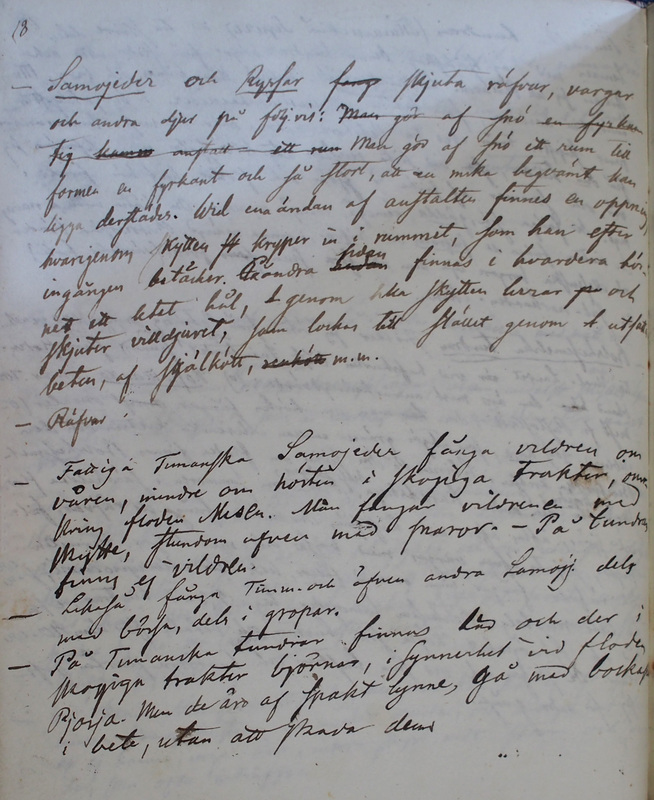Ethnographiska, historiska och statistiska anmärkningar. 018
Title
Ethnographiska, historiska och statistiska anmärkningar. 018
Description
| Samojeder och Ryssar skjuta
räfvar,
vargar Fox furs were one of the most significant items in trade and taxation. They were hunted with different kinds of traps, such as snares and foothold traps, and with crossbows. (Chomič 1966: 70–71)
och andra djur på följ. vis: Man gör af snö en fyrkant sig - ett rum Man gör af snö ett rum till formen en fyrkant och så stort, att en mska[människa] beqvämt kan ligga derstädes. Wid ena ändan af anstalten finnes en öppnung hvarigenom skytten kryper in i rummet, som han efter ingången betäcker. På andra sidan finnas i hvardera hör- net ett litet hål, genom hka[hvilka] skytten lurar på och skjuter villdjuret, som lockas till stället genom utfall beten, af skjälkött, renkött m.m. |
The Samoyeds and Russians shoot foxes, wolves, and other animals in the following manner: one makes a square shaped-room of snow. The room is made so large that a man can comfortably lie there. At one end of the building there is an opening through which the shooter crawls into the room, which he covers after entering. On the other side, in each corner, there is a small hole, through which the shooter lurks and shoots wild animals which are attracted to the place with the help of baits such as seal and reindeer meat. |
| Räfvar Fattiga Timanska Samojeder fånga vildren om våren, mindre om hösten i skogiga trakter, om- kring floden Mesen. Man fångar vildrenen med skytte, stundom äfven med snaror. - På tundran finns ej vildren. Likaså fånga Timm[Timanska]. och äfven andra Samojj.[Samojeder] dels med bössa, dels i gropar.
Before the development of a pastoralist reindeer economy, hunting wild reindeer provided the Nenets with food, materials for the tent, clothing, and utensils such as rope. They are still hunted, but on a lesser scale. Wild reindeer could be hunted collectively or individually. It took place on the customary migration routes of the reindeer or in their autumn pastures. In collective hunting the reindeer were driven to specifically built corridors and shot in the narrower part of the corridor. Additionally, reindeer were speared when they were crossing rivers during the migration. Individually, the wild reindeer could be killed in a chase or with the help of reindeer that was used to attract them or by using crossbows together with a tripwire. (Haakansson 2000; Fëdorova 2016; Anderson et al. 2019)
På Timanska tundran finns här och der i skogiga trakter björnar,
i synnerhet vid flodenThe Nenets are known to have hunted both polar bears (TN сэрʹ варк) and brown bears (TN варк) and, as noted by Chomič, there seem to have been regulations and restrictions related to brown bears but not so much to the polar ones, although the polar bear was considered sacred. The polar bear was hunted mainly for its fur and fat. (Lehtisalo 1924: 50–53; Lehtisalo 1956: 181b; Chomič 1966: 69–70; 135)
Pjosja. Men de äro af spakt lynne, gå med boskap i bete, utan att skada dem. The Nenets are known to have hunted both polar bears (TN сэрʹ варк) and brown bears (TN варк) and, as noted by Chomič, there seem to have been regulations and restrictions related to brown bears but not so much to the polar ones, although the polar bear was considered sacred. The polar bear was hunted mainly for its fur and fat. (Lehtisalo 1924: 50–53; Lehtisalo 1956: 181b; Chomič 1966: 69–70; 135)
|
Foxes The poor Timan Samoyeds hunt wild reindeer in the spring, less so in the autumn, in wooded areas around the River Mesen. Wild reindeer are shot and sometimes also snared. – There are no wild reindeer on the tundra. Similarly, the Timan and also other Samoyeds hunt partly with rifles, partly with the help of pits.Bears can be found here and there in the Timan tundra’s wooded areas, especially by the River Pjosja. Nevertheless, they are calm-tempered, and graze with cattle without harming them. |

